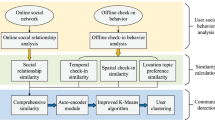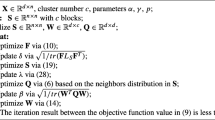Abstract
We propose a computational model to learn the common sense association between a pair of concept classes based on a bipartite network and matrix factorization methods. We view the concept-pair association as a bipartite network so that the autoassociation mappings can become similarity constraints. We impose the additional similarity and regularity constraints on the optimization objectives so that a mapping matrix can be found in the matrix factorization to best fit the observation data. We extract 139 locations and 436 activities and 667 location–activity pairs from ConceptNet (http://conceptnet5.media.mit.edu/). We evaluate the performance in terms of F-factor, precision, and recall using a common sense association problem between locations and activities against four feature selection strategies in the matrix factorization optimization. The comparison between the performances with and without human judgment reveals that matrix factorization method tends to show good generalization even under very little observation evidence. Among the four feature selection methods, the maximal entropy method performs better in terms of F-score and recall when the feature number is more than 30 % while SVD method performs better in terms of F-score and recall when the feature number is less than 30 %. Random selection can have a higher precision given “enough” features, but it tends to be the worst performer in the recall and F-score.






Similar content being viewed by others
References
Brewka, G.: Nonmonotonic Reasoning: Logical Foundations of Commonsense. Cambridge University Press, Cambridge (1991)
Iwasaki, Y.: Real-world applications of qualitative reasoning. IEEE Expert 12(3), 16–21 (1997)
De Kleer, J., Brown, J.S.: A qualitative physics based on confluences. Artif Intell 24(1–3), 7–83 (1984)
Sloman, S.A.: The empirical case for two systems of reasoning. Psychol Bull 119(1), 3–22 (1996)
Bruck, J.: On the convergence properties of the hopfield model. In: Proceedings of the IEEE, 78(10), October (1990)
Kosko, B.: Bidirectional associative memory. IEEE Trans. Syst. Man Cybern. 18(1), 49–60 (1988)
Liou, C.-Y., Yuan, S.-K.: Error tolerant associative memory. Biol. Cybern. 81, 331–342 (1999)
Koren, Y., Bell, R., Volinsky, C.: Matrix factorization techniques for recommender systems. IEEE Comput. 42(8), 30–37 (2009)
Lee, D.D., Seung, H.S.: Learning the parts of objects by non-negative matrix factorization. Nature 401, 788–791 (1999)
Chen, T.-C., Soo, V.-W.: Learning common sense associations based on a bipartite network using matrix factorization. In: Proceedings of ISIS (2015)
ConceptNet, http://conceptnet5.media.mit.edu/
Tremblay, C., et al.: Bidirectional associative memory and learning of nonlinearly separable tasks. In: Proceedings of ICCM, (2013)
Acevedo-Mosqueda, M.E., Yanez-Marquez, C., Acevedo-Mosqueda, M.A.: Bidirectional associative memories: different approaches. ACM Comput. Surv. 45(2), 18:1–18:30 (2013)
Vedantam, R., et al.: Learning common sense through visual abstraction. In: ICCV (2015)
Zang, L.-J., et al.: A survey of commonsense knowledge acquisition. J. Comput. Sci. Technol. 28(4), 689–719 (2013)
Acknowledgments
This research is supported in part by Ministry of Science and Technology of Taiwan, ROC under the Grant Number 104-2221-E007-094-MY2.
Author information
Authors and Affiliations
Corresponding author
Rights and permissions
About this article
Cite this article
Chen, TC., Soo, VW. Feature Selection in Learning Common Sense Associations Using Matrix Factorization. Int. J. Fuzzy Syst. 19, 1217–1226 (2017). https://doi.org/10.1007/s40815-016-0235-4
Received:
Revised:
Accepted:
Published:
Issue Date:
DOI: https://doi.org/10.1007/s40815-016-0235-4




